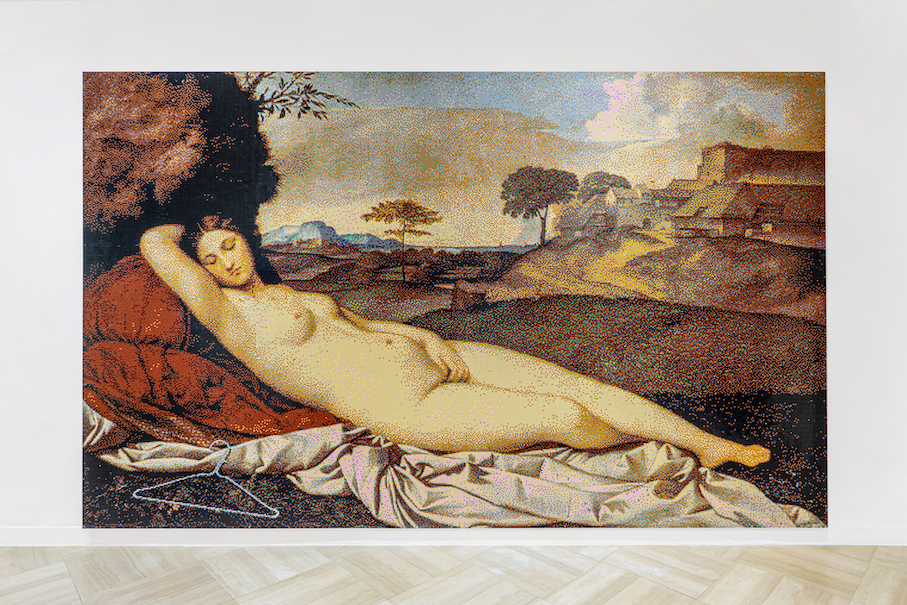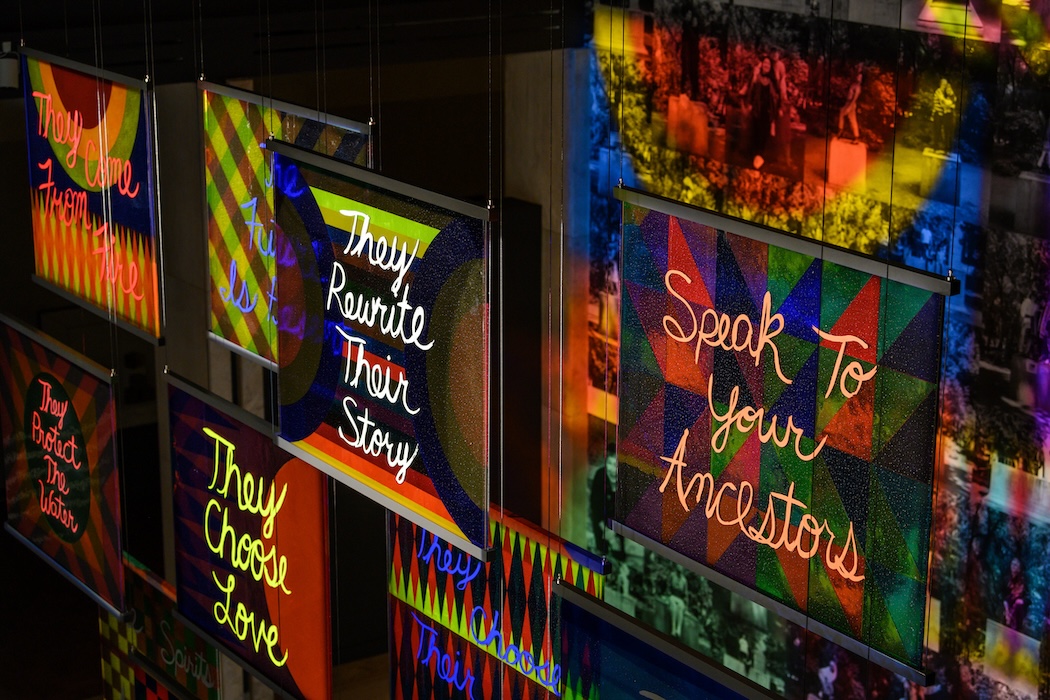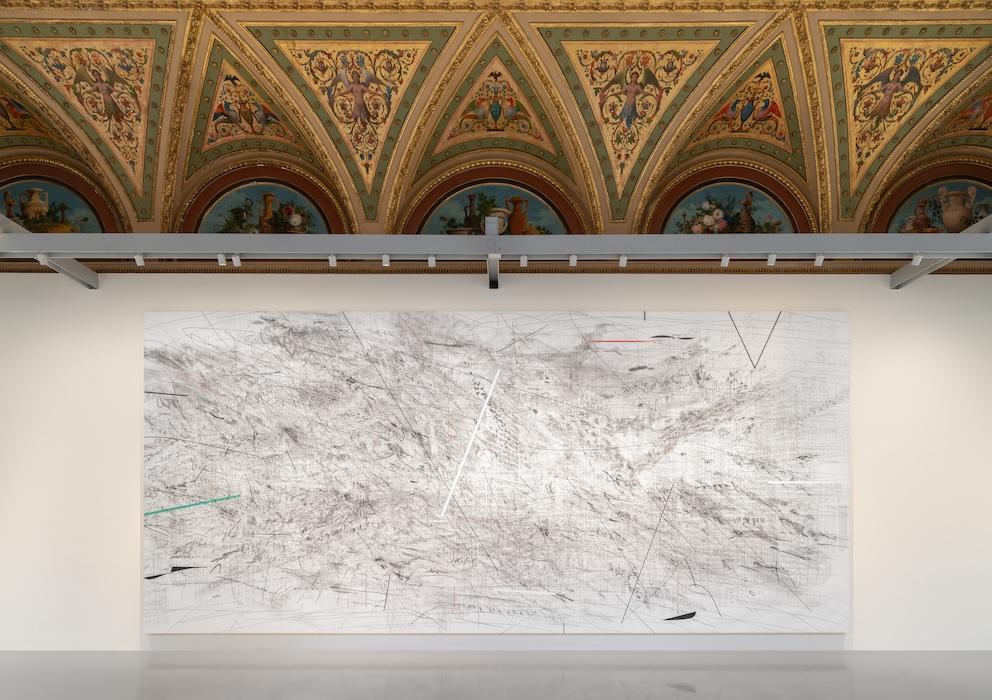AUSTRALIAN PAVILION
TRACEY MOFFATT: My Horizon
The Australian Pavilion will present Tracey Moffatt’s “My Horizon,” an installation of new work that includes film and photography which presents fictional narratives to explore journeys both legal and illegal, and confront some of today’s most salient global issues, including the migrant crisis. Moffatt explores the meaning of a horizon line—be it a reference the future, the out-of- reach, or the passage of time. Curated by Natalie King and commissioned by Naomi Milgrom AO, the exhibition will be accompanied by a publication from Thames & Hudson.
AUSTRIAN PAVILION
ERWIN WURM AND BRIGITTE KOWANZ
The Austrian pavilion will present the work of two artists this year: Brigitte Kowanz and Erwin Wurm. Both work within the medium of sculpture, playing with notions involving new material and architecture. Kowanz’s work explores themes of light, language, and mirrors in what has been describe as “conceptual poetry.” Wurm interacts more directly with the body—whether by asking it to pose with everyday objects or by stretching, plumping, or squeezing architectural frameworks.
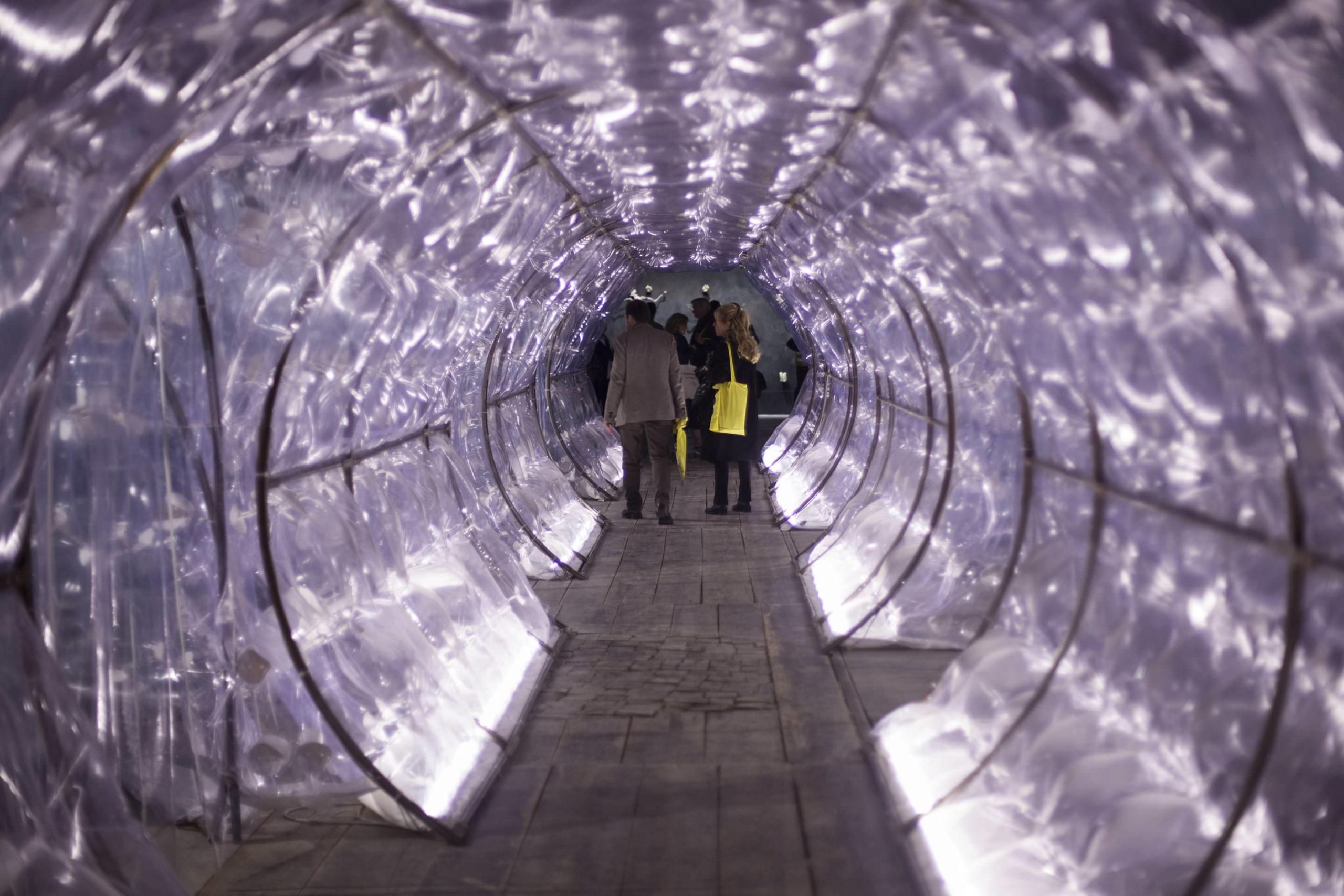
ITALIA Pavilion
Italo Rondinella
Courtesy of La Biennale di Venezia
BELGIAN PAVILION
DIRK BRAECKMAN
A series of large-scale photographic prints by Dirk Braeckman will be presented at the Belgian Pavilion. The new work is a response to the speed of images. The artist aimed to make work that can’t be taken in at just a glance. Braeckman created powerful photos that engage directly with the viewer, establishing, as he describes, “stillness against today’s influx of images and information.”
BRAZILIAN PAVILION
CINTHIA MARCELLE
Cinthia Marcelle started with the Brazilian Pavilion, designed by Henrique E. Mindlin and Giancarlo Palanti in the late 1950s. The artist’s installation responds to the building’s modernist architecture and reflects on its history of displaying art. Visitors will be introduced to a slight sense of instability with a large sculpture acting as an inclined floor. Also on view will be drawings, paintings, sculptures, and works in other media Marcelle made with collaborators, such as a video work created with Tiago Mata Machado.
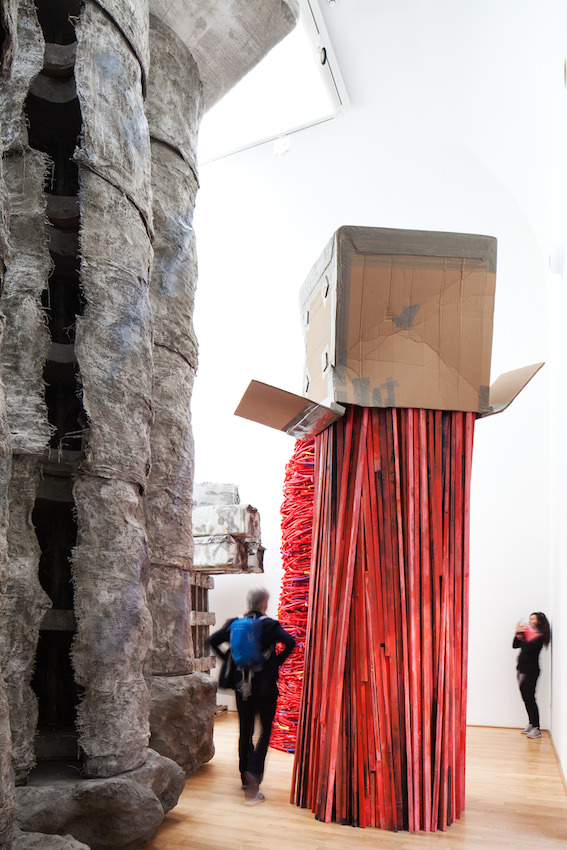
GREAT BRITAIN Pavilion
photo by Francesco Galli
Courtesy of La Biennale di Venezia
BRITISH PAVILION
PHYLLIDA BARLOW
Phyllida Barlow is known for her massive sculptures that employ low-cost material like plaster, cement, and plywood. Her solo exhibition this year in Venice will transform the neoclassical architecture of the British Pavilion. Barlow, who has been making work since the 1960s, creates ambitious immersive installations that exude the feeling of the process of creating. Her palette mimics her choice of material, and she often uses scale to reach surprising parts of the gallery space, such as overlooked corners or high-up rafters. She generously does not hide the human touch and physicality required in her practice.
CANADIAN PAVILION
GEOFFREY FARMER
Geoffrey Farmer’s “A way out of the mirror” takes over the inside and even the outside of the Canadian Pavilion, which has been opened up to reveal the surrounding gardens. The project began with two unpublished press photos from 1955 showing a collision between a train and lumber truck at a railway crossing. Farmer’s grandfather was involved in the accident and tragically died soon after. This trauma was unspoken in Farmer’s family for many years and only resurfaced last year when the artist received the images from his sister. Exploring the multiple manifestations of collision, contemplation, and reflection, the exhibition reimagines the pavilion in the guise of a fountain, from which water flows.
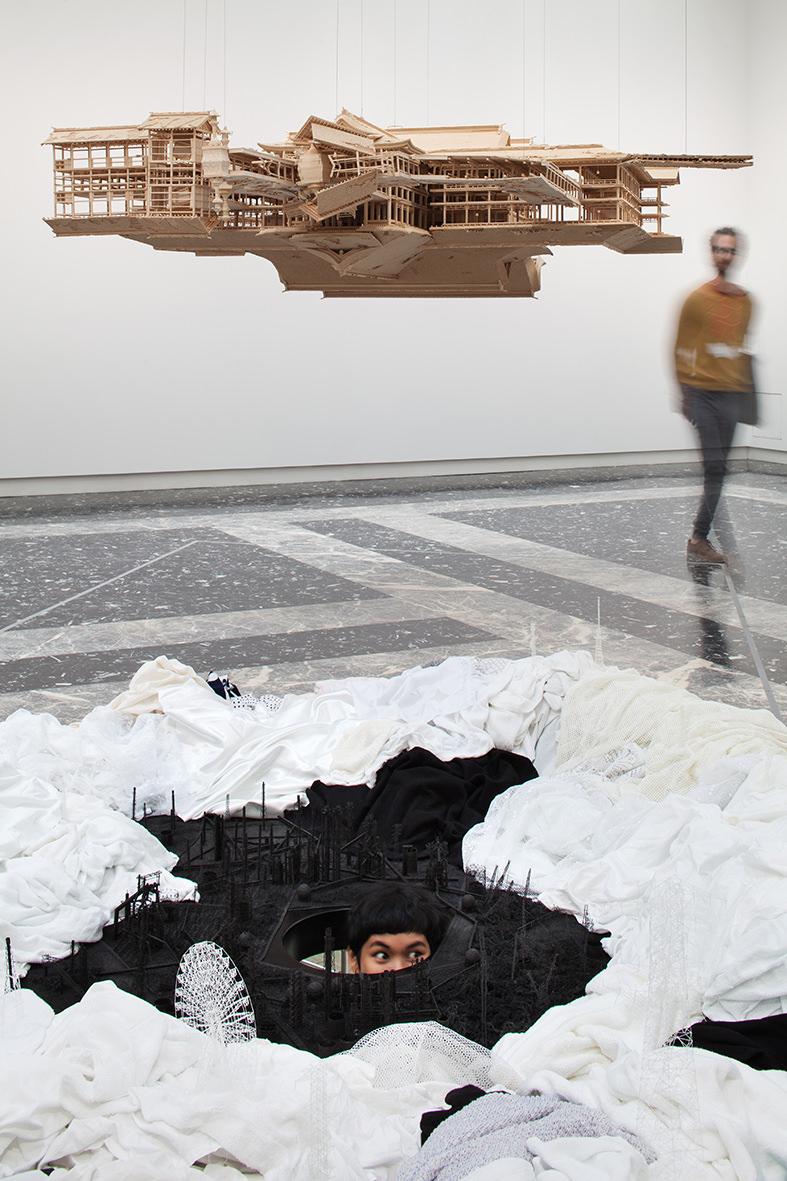
JAPAN Pavilion
Photo by Francesco Galli
Courtesy of La Biennale di Venezia
DANISH PAVILION
KIRSTINE ROEPSTORFF INFLUENZA: Theatre of Glowing Darkness
Kirstine Roepstorff will present “INFLUENZA: Theatre of Glowing Darkness.” The exhibition looks at what happens between the end of the known and the beginning of the new. The show will investigate questions of choice, risk, and memory. It will ask, “When everything was just floating energy in complete darkness . . . How much did you dare to risk in order to grow? How much darkness did you absorb?”
FINNISH PAVILION
ERKKA NISSINEN AND NATHANIEL MELLORS: The Aalto Natives
The artists Nathaniel Mellors and Erkka Nissinen have collaborated for the first time in “The Aalto Natives.” Both are known for the comedic narrative of their work, which deals with issues of morality and power. Nissinen has gained acclaim for his video and installation work. Mellors’s practice involves sculpture, performance, and video as well. Together, they have taken a “comic- cosmic perspective” on nationalism, identity, and creation mythology via an absurdist satire.
FRENCH PAVILION
XAVIER VEILHAN: Studio Venezia
Xavier Veilhan has created a musical pavilion, building a working recording studio inspired by Kurt Schwitters’s Merzbau (1923–37). The artist invites musicians to create their own art throughout the seven months of the exhibition. Visitors will be able to witness firsthand music being made by some one hundred international and local musicians. Veilhan wants the studio project to be the beginning of an ongoing project, which he describes as a “musical reflector.”
GERMAN PAVILION
ANNE IMHOF
Anne Imhof’s work includes painting, sculpture, installation, and performance. For the biennale, the artist created a work that interacts spatially and temporally within the German Pavilion. Her performers are postgender and individualized. Each is image-ready, anticipating of the chance to become a digital commodity.
ICELANDIC PAVILION
EGILL SÆBJÖRNSSON: Out of Control in Venice
Two trolls turned artists, Ugh and Bõögâr, were given full reign of the Icelandic Pavilion by artist Egill Sæbjörnsson. The transfer of power results in the fantasy-driven “Out of Control in Venice,” which asks the question, “Who is guiding our actions, thoughts, and even imagination?” As the story goes, in 2008 the artist first encountered Ugh and Bõögâr, who now follow him wherever he goes, sharing his studio and even creating works and exhibitions.
IRAQI PAVILION
SHERKO ABBAS, ALI ARKADY, LUAY FADHIL, NADINE HATTOM, SADIK KWAISH ALFRAJI, SAKAR SLEMAN, JAWAD SALIM, SHAKER HASSAN AL SAID, AND FRANCIS ALŸS: Archaic
The Ruya Foundation—the only organization working inside Iraq to preserve contemporary culture—loaned ancient and retrieved artifacts for the first time internationally for the exhibition “Archaic.” The show includes eight modern and contemporary Iraqi artists alongside 40 ancient works spanning six millennia, and accompanies a new commission by Francis Alÿs that deals with war and the role of the artist. Navigating Iraq’s fragile reality, “Archaic” highlights universal themes connecting today with the distant past.
IRISH PAVILION
JESSE JONES: Tremble Tremble
“Tremble Tremble” includes a film and performance that, as artist Jesse Jones describes it, bewitch the judicial system. Jones will use the Irish Pavilion to create a site of alternative law, proposing the return of the witch as a feminist archetype who has the potential to transform reality. The artist found inspiration for the title of the exhibition in the Italian movement of the 1970s for housework wages, where women cried, “Tremble, tremble, the witches have returned!”
ISRAELI PAVILION
GAL WEINSTEIN: Sun Stand Still
The fruits of the past decade of Gal Weinstein’s practice are woven into this multi-site-specific installation. “Sun Stand Still” continues the artist’s interest in stopping time, destruction, and devastation. Tapping into romantic ideas and images of Zionism is Moon over Ayalon Valley, a monumental piece that depicts the tale of the conquest of Canaan by Joshua Bin-Nun, who called on the sun and moon to halt. Using unique materials, the installation will take up three levels and spill out into the pavilion’s courtyard.
ITALIAN PAVILION
GIORGIO ANDREOTTA CALÒ, ROBERTO CUOGHI, AND
ADELITA HUSNI-BEY
Curator Cecilia Alemani chose the artists Giorgio Andreotta Calò, Roberto Cuoghi, and Adelita Husni-Bey to represent Italy. The artists’ work is tied to Italian culture, despite their coming of age in a global art scene, having been born between the mid-1970s and ’80s. The name of the exhibition, “Il Mondo Magico,” comes from the book by Ernesto de Martino, who studied the use of magic to deal with crises in various cultures. The work of Andreotta Calò, Cuoghi, and Husni-Bey reimagines reality in a variety of ways to better confront the world today.
JAPANESE PAVILION
TAKAHIRO IWASAKI: Turned Upside Down, It’s a Forest
Takahiro Iwasaki has created a multifaceted spatial experience of viewing the Itsukushima Shrine located in Hiroshima, where the artist was born, raised, and continues to work. Viewers can see the site from the perspective of a bird, insect, or fish, skewing the perception of time, material, and reality. The artist has explored Japan’s rural landscape in his previous work, and furthers that investigation with this project by imagining the site seen from land and by sea. The exhibition title, “Turned Upside Down, It’s a Forest,” comes from the idea that Venice would look like a forest if it were flipped, since it was built on stakes within a lagoon.
KOREAN PAVILION
CODY CHOI AND LEE WAN
Counterbalance: The Stone and the Mountain
In “Counterbalance: The Stone and the Mountain,” Cody Choi and Lee Wan engage with the spawning disparity they encountered in their transnational journey to find their own identity. Current international political movements such as right-wing populism and restrictions on immigration influenced these two artists to delve into the borderless issues of glocalism. Choi came to prominence in New York art scene in the 1990s, a time of considerable turmoil in Korea. He created Venetian Rhapsody, a cluster of neon signs to critique “casino capitalism.” Lee Wan comes from a younger generation, and is debuting an installation of 600 clocks engraved with the personal details of people the artist met while traveling around the world, entitled Proper Time.
LEBANESE PAVILION
ZAD MOULTAKA: ŠamaŠ: Sun Dark Sun
“ŠamaŠ: Sun Dark Sun” marks a return for Lebanon to the international exhibition in Venice. In it, the multidisciplinary artist Zad Moultaka is showing his monumental work ŠamaŠ—mixing sound and sight, invention and research, new technology with the archaic. ŠamaŠ is the Babylonian god of the sun and justice depicted on what is considered the first law table, the Code of Hammurabi, made two thousand years before the Common Era. Connecting the foretold Arab end of days with today’s wars in places like Syria, Moultaka considers, “Who is ŠamaŠ today?”
MALTA PAVILION
HOMO MELITENSIS
“Homo Melitensis: An incomplete inventory in 19 chapters” is a conceptual exhibition curated by artists Raphael Vella and Bettina Hutscheck. Bringing together a collective of 13 artists, the project marks the return of the Malta Pavilion to Venice for the first time in 17 years. The exhibition is designed in collaboration with Tom Van Malderen’s Architecture Project.
MEXICAN PAVILION
CARLOS AMORALES: The Life in the Folds
The title of Carlos Amorales’s “Life in the folds” refers to the Henri Michaux’s 1949 novel. It is the product of the artist’s research into formal language, resulting in an installation that includes a set of encrypted poems that involve sound and symbol, a painting from the series entitled “The geometric splendor,” and the film The cursed village, which follows the tragic journey of a migrant family via a miniature puppet theater, which will be used for further performance during the exhibition.
NEW ZEALAND PAVILION
LISA REIHANA: Emissaries
“Lisa Reihana: Emissaries” features the artist’s panoramic video in Pursuit of Venus [infected] (2015–17), including a reimagining of Les Sauvages de la Mer Pacifique from the early 19th century. Reihana has reanimated the French scenic wallpaper, also known as Captain Cook’s Voyages, creating a more complex story that dramatizes the fatal end for Cook in Hawaii. A score of the live performance, Cook’s original ticking travel clock, and rare recordings of Maori instruments further intensify the visual experience.
NORDIC PAVILION
SIRI AURDAL, NINA CANELL, CHARLOTTE JOHANNESSON, JUMANA MANNA, PASI “SLEEPING” MYLLYMÄKI, AND MIKA TAANILA: Mirrored
Mats Stjernstedt has curated “Mirrored,” featuring the work of six multigenerational artists— Siri Aurdal, Nina Canell, Charlotte Johannesson, Jumana Manna, Pasi “Sleeping” Myllymäki, and Mika Taanila. Instead of one overarching theme, the exhibition challenges the self-image and stereotypes projected onto the Nordic countries of Finland, Norway, and Sweden. While some artists represent ahead-of-its-time urbanity, others explore politics and material. On view is a range of work—film, craft, sculpture, sound, and installation—that confronts both the architecture of the Nordic Pavilion and preconceived notions of Nordic expression.
POLISH PAVILION
SHARON LOCKHART: Little Review
Sharon Lockhart’s project “Little Review” is created in collaboration with the young women of the Youth Center for Socio-Therapy of Rudzienko, with whom she has a longstanding relationship. The name “Little Review” is taken from a historical newspaper supplement, published from 1926 to 1939, that featured articles written exclusively by children and teenagers. The young women of Rudzienko engaged with this archive to select 29 issues, which will be translated to English and distributed weekly in the pavilion over the course of the biennale. The project also features a new film and series of photographs, as well as educational workshops for these young women.
RUSSIAN PAVILION
GRISHA BRUSKIN, RECYCLE GROUP, AND SASHA PIROGOVA: Theatrum Orbis
Artists Grisha Bruskin, Recycle Group, Sasha Pirogova, and composer Dmitri Kourliandski are part of “Theatrum Orbis,” bringing together sculpture, sound, video, and installation in four parts. Bruskin’s figurative sculptures on entry lead to a labyrinth of rooms with works by Recycle Group and Pirogova. The name of the project translates to “Theater of the World,” which relates to the first modern atlas, made by Abraham Ortelius in 1570 during the Age of Discovery.
SOUTH AFRICAN PAVILION
CANDICE BREITZ AND MOHAU MODISAKENG
This two-person exhibition marks the first time the work of Candice Breitz and Mohau Modisakeng will be shown together within such a significant space. Modisakeng’s practice uses a personal language to explore ideas around nationhood, inequality, identity, migrant labor, and the body, grappling with black male identity, body, and place within a post- apartheid context. Breitz, working in photography and video, creates installations that engage with issues of empathy, race, gender, and religion, as well as more recently investigating the impact of the global media in which celebrity-driven culture runs parallel to indifference toward real-world adversities.
SPANISH PAVILION
JORDI COLOMER: ¡Únete! Join Us!
“¡Únete! Join Us!” by Jordi Colomer is a participatory exhibition curated by Manuel Segade, director of CA2M Centro de Arte Dos at the Comunidad de Madrid, and conceived as an installation of installations. Via a path suggested by several videos, visitors become actors within theater-like transitory spaces that mimic an abandoned racetrack, an emergency trailer park, or a tourist-ridden Mediterranean coast. Along the journey will be unexpected encounters, playful gestures, and potential exchanges. Colomer is playing with ideas around public and private space, as well as social, political, and physical movement.
SWISS PAVILION
CAROL BOVE AND TERESA HUBBARD/ ALEXANDER BIRCHLER: Women of Venice
Curator Philipp Kaiser curated “Women of Venice” showcasing the work of artists Carol Bove and Teresa Hubbard / Alexander Birchler. The exhibition looks into Alberto Giacometti’s absence from the Swiss Pavilion. He declined all requests during his lifetime to represent Switzerland at the Venice Biennale—even though Albert’s own brother, Bruno Giacometti, built the Swiss Pavilion in 1952. Each artist has created new work for the project that addresses the legacy of Giacometti: Hubbard and Birchler’s film installation Flora and Bove’s sculptural constellations.
PAVILION OF TURKEY
CEVDET EREK: ÇIN
“ÇIN” is a site-specific sound-based work by the artist Cevdet Erek, who is known for his installations and performance, as well as his experience in architecture and the music band Nekropsi. “ÇIN” is open to participants, created in collaboration with Yelin Bilgin, Gürden Gür, Elif Tunçel, Ayşe Erek, and Yetkin Başarır. Following past works like Room of Rhythms, Rulers and Rythms Studies, and Sound Ornamentations, this project is steeped in memory and sound.
UNITED STATES PAVILION
MARK BRADFORD: Tomorrow Is Another Day
“Mark Bradford’s “Tomorrow Is Another Day” brings together new and existing work by the Los Angeles–based artist. It also marks the beginning of the artist’s six-year collaboration with Rio Terà dei Pensieri, a Venice social cooperative nonprofit that provides employment for incarcerated men and women, aiding in their reintegration into society. A storefront in the city selling artisanal goods and other products from the program opened to the public in April; the entirety of its sales proceeds will help sustain Rio Terà for years to come. Bradford is using the world stage of the biennale to discuss the shortcomings of the prison system and the disadvantages former inmates face upon rehabilitation.
ZIMBABWEAN PAVILION
CHARLES BHEBE, ADMIRE KAMUDZENGERERE, SYLVESTER MUBAYI, AND DANA WHABIRA
This is Zimbabwe’s fourth time showing at the Venice Biennale. The presentation offers a variety of mediums that explore a variety of perspectives on themes of patriotism, belonging, migration, and identity. It will showcase sculptures by Sylvester Mubayi, the oldest participant who is part of the country’s first generation of stone sculptors. In addition, the pavilion will present a collaborative performance work dealing with power, gender, and race by Admire Kamudzengerere and the Israeli artist Rachel Monosov, as well as a conceptual work from the architect, artist, and curator Dana Whabira.
Pick up your copy of Whitewaller Venice, out now.





